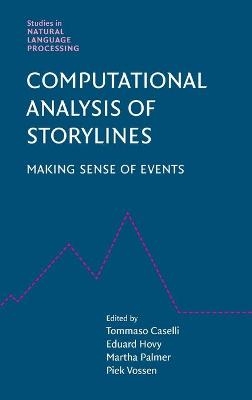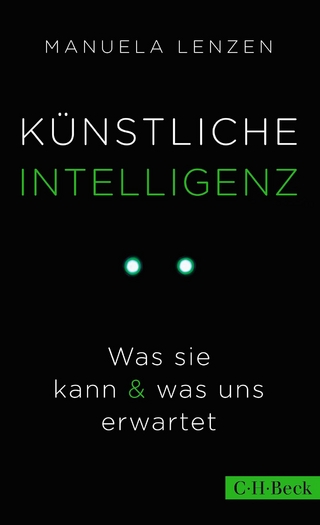
Computational Analysis of Storylines
Cambridge University Press (Verlag)
978-1-108-49057-3 (ISBN)
Event structures are central in Linguistics and Artificial Intelligence research: people can easily refer to changes in the world, identify their participants, distinguish relevant information, and have expectations of what can happen next. Part of this process is based on mechanisms similar to narratives, which are at the heart of information sharing. But it remains difficult to automatically detect events or automatically construct stories from such event representations. This book explores how to handle today's massive news streams and provides multidimensional, multimodal, and distributed approaches, like automated deep learning, to capture events and narrative structures involved in a 'story'. This overview of the current state-of-the-art on event extraction, temporal and casual relations, and storyline extraction aims to establish a new multidisciplinary research community with a common terminology and research agenda. Graduate students and researchers in natural language processing, computational linguistics, and media studies will benefit from this book.
Tommaso Caselli is an Assistant Professor in Computational Semantics at the University of Groningen. He received his PhD in computational linguistics on temporal processing of texts from the University of Pisa. His main research areas are in discourse processing, event extraction, and (event) sentiment analysis. He is one of the founders of the 'Event and Stories in the News' workshop series, and is currently working on developing computational models and NLP tools to extract plot structures from news. He took part in organizing semantic evaluation campaigns in NLP for English and Italian. Eduard Hovy is a Research Professor at the Language Technology Institute at Carnegie Mellon University. He was was awarded honorary doctorates from the National Distance Education University (UNED) in Madrid in 2013 and the University of Antwerp in 2015. He is one of the initial 17 Fellows of the Association for Computational Linguistics (ACL). His research contributions include the co-development of the ROUGE text summarization evaluation method, the BLANC coreference evaluation method, the Omega ontology, the Webclopedia QA Typology, the FEMTI machine translation evaluation classification, the DAP text harvesting method, the OntoNotes corpus, and a model of Structured Distributional Semantics. Martha Palmer is a Professor at the University of Colorado in Linguistics, Computer Science and Cognitive Science. She is a AAAI Fellow and an ACL Fellow. She works on trying to capture elements of the meanings of words that can comprise automatic representations of complex sentences and documents. She is a co-editor of Linguistic Issues in Language Technology, and has been on the CLJ Editorial Board and a co-editor of JNLE. She is a past President of the Association for Computational Linguistics, past Chair of SIGLEX and SIGHAN, and was the Director of the 2011 Linguistics Institute held in Boulder, CO. Piek Vossen is Professor at Vrije Universiteit Amsterdam. He is the co-founder and co-president of the Global Wordnet Association, organizing the international Wordnet conferences since 2002. In 2013, he received the Dutch Spinoza prize for his research. He used this prize to launch a series of projects among which the structuring of news streams using storylines and reader/writer perspectives. Vossen's current main research focuses on cross-document event co-reference and perspective modeling of multiple sources with respect to event data and modeling event implications, as well as event timelines and storylines.
Introduction and Overview Tommaso Caselli, Martha Palmer, Ed Hovy, and Piek Vossen; Part I. Foundational Components of Storylines: 1. The Role of Event-Based Representations and Reasoning in Language James Pustejovsky; 2. The Rich Event Ontology – Ontological Hub for Event Representations Claire Bonial, Susan W. Brown, Martha Palmer, and Ghazaleh Kazeminejad; 3. Decomposing Events and Storylines William Croft, Pavlìna Kalm and Michael Regan; 4. Extracting and Aligning Timelines Mark Finalyson, Andres Cremisini, and Mustafa Ocal; 5. Event Causality Paramita Mirza; 6. A Narratology-Based Framework for Storyline Extraction Piek Vossen, Tommaso Caselli, and Roxane Segers; Part II. Connecting the Dots: 7. The Richer Event Description Corpus for Event-Event Relations Tim O'Gorman, Kristin Wright-Bettner, and Martha Palmer; 8. Low-Resource Event Extraction via Share-and-Transfer and Remaining Challenges Heng Ji and Clare Voss; 9. Reading Certainty across Sources Ben Miller; 10. Narrative Homogeneity and Heterogeneity in Document Categories Dan Simonson and Tony Davis; 11. Exploring Machine-Learning Techniques for Linking Event Templates Jakub Piskorski, Fredi Šarić, Vanni Zavarella, and Martin Atkinson; 12. Semantic Storytelling – from Experiments and Prototypes to a Technical Solution Georg Rehm, Karolina Zaczynska, Peter Bourgonje, Malte Ostendorff, Julián Moreno-Schneider, Maria Berger, Jens Rauenbusch, André Schmidt, Mikka Wild, Joachim Böttger, Joachim Quantz, Jan Thomsen, and Rolf Fricke.
| Erscheinungsdatum | 03.12.2021 |
|---|---|
| Reihe/Serie | Studies in Natural Language Processing |
| Zusatzinfo | Worked examples or Exercises |
| Verlagsort | Cambridge |
| Sprache | englisch |
| Maße | 156 x 233 mm |
| Gewicht | 510 g |
| Themenwelt | Geisteswissenschaften ► Sprach- / Literaturwissenschaft ► Sprachwissenschaft |
| Informatik ► Theorie / Studium ► Künstliche Intelligenz / Robotik | |
| Sozialwissenschaften ► Kommunikation / Medien ► Medienwissenschaft | |
| ISBN-10 | 1-108-49057-3 / 1108490573 |
| ISBN-13 | 978-1-108-49057-3 / 9781108490573 |
| Zustand | Neuware |
| Informationen gemäß Produktsicherheitsverordnung (GPSR) | |
| Haben Sie eine Frage zum Produkt? |
aus dem Bereich


